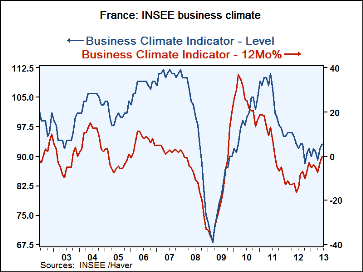 Global| Jun 25 2013
Global| Jun 25 2013French Businessmen See Some Improvement
Summary
French business climate according to the INSEE index is up to 93 in June from 92 in May with May itself having risen to 92 from 89. The chart shows that there is some slight ongoing improvement but mostly that the downtrend in [...]
 French business climate according to the INSEE index is up to 93 in June from 92 in May with May itself having risen to 92 from 89. The chart shows that there is some slight ongoing improvement but mostly that the downtrend in business confidence has been halted. The two-line chart of this activity shows the current index moving up slightly; there is more progress registered in terms of year-over-year improvement owing to a comparison with even weaker conditions in June of one year ago.
French business climate according to the INSEE index is up to 93 in June from 92 in May with May itself having risen to 92 from 89. The chart shows that there is some slight ongoing improvement but mostly that the downtrend in business confidence has been halted. The two-line chart of this activity shows the current index moving up slightly; there is more progress registered in terms of year-over-year improvement owing to a comparison with even weaker conditions in June of one year ago.
The recent trend is still poor at a reading of -42 but it’s better than -46 in May and -49 in April. The ‘likely trend’ at zero is better than the -2 reading for May and for April. New orders/demand situation overall has improved to -30 from -31 and that was an improvement from -40 back in April. The foreign orders situation hasn’t really improved very much. In the month its gain to -27 from -29 is still weaker than the -26 of April or the -25 from March. What we see is some sense of improved domestic orders and in domestic demand conditions compared to international orders and conditions. The ‘likely sales price trend’ remains negative and while the June reading is a modest improvement from May, April still is much weaker than it was in March.
Viewed in an historic context the climate reading is in the bottom 26% of its historic queue of values back to early 1990. The weakest relative reading is from the ‘recent trend’ which stands in the 12 percentile of its historic queue implying that it has been weaker than this only 12% of the time historically. Orders and demand as well as foreign orders and demand are both weak and stand approximately the lower 24th percentile of their respective historic queues. Only slightly better is the ‘likely sales price trend’ which is in the bottom 26 percentile of its historic queue. Slightly more optimistic and I emphasize that it’s only slightly optimistic is the ‘likely trend reading’ which is in about the lower 30th percentile of its historic queue. Queue standings are still extremely week. A brief perusal of the chart shows how weak the current numbers are compared to recent historic experience. The chart also shows the meager sense of improvement and of acceleration in the current numbers.
While it’s true that business confidence has improved it’s also true that it hasn’t approved by much. Climate is only back to a level that is very marginally better than what the readings have been and only back to what the readings were in September of last year. France continues to struggle.
On other fronts the UK survey of retail sales in June produced a standoff with nearly as many retailers reporting improve sales as reported worse sales. Weather has been a problem for retail sales in the UK and retailers are hoping that they’ll be a reversal so that sales can improve next month. In Italy, retail sales declined for the eighth consecutive month in April although the pace of decline slowed slightly.
The bottom line is that between what businesses are seeing what consumers are experiencing the euro-Zone continues to be under a great deal of pressure and continues to be waffling. The recent financial turmoil in markets is doing nothing to help the circumstances. It appears that we may have moved into another danger zone - maybe not a major danger zone- but it appears to be a danger zone nonetheless. It appears to be prompted by concerns about shifted Federal Reserve policy and what that will mean for the US and the rest of the world’s growth as well as financial markets performance. In addition it appears to have unveiled a credit bubble that is percolating in China and that could prove to be more of a risk factor for the rest of the world. That bears extremely close scrutiny.

Robert Brusca
AuthorMore in Author Profile »Robert A. Brusca is Chief Economist of Fact and Opinion Economics, a consulting firm he founded in Manhattan. He has been an economist on Wall Street for over 25 years. He has visited central banking and large institutional clients in over 30 countries in his career as an economist. Mr. Brusca was a Divisional Research Chief at the Federal Reserve Bank of NY (Chief of the International Financial markets Division), a Fed Watcher at Irving Trust and Chief Economist at Nikko Securities International. He is widely quoted and appears in various media. Mr. Brusca holds an MA and Ph.D. in economics from Michigan State University and a BA in Economics from the University of Michigan. His research pursues his strong interests in non aligned policy economics as well as international economics. FAO Economics’ research targets investors to assist them in making better investment decisions in stocks, bonds and in a variety of international assets. The company does not manage money and has no conflicts in giving economic advice.






